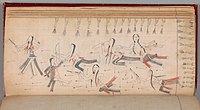
The Arapaho are a Native American people historically living on the plains of Colorado and Wyoming. They were close allies of the Cheyenne tribe and loosely aligned with the Lakota and Dakota.

The Cheyenne are an Indigenous people of the Great Plains. Their Cheyenne language belongs to the Algonquian language family. Today, the Cheyenne people are split into two federally recognized nations: the Southern Cheyenne, who are enrolled in the Cheyenne and Arapaho Tribes in Oklahoma, and the Northern Cheyenne, who are enrolled in the Northern Cheyenne Tribe of the Northern Cheyenne Indian Reservation in Montana. The Cheyenne comprise two Native American tribes, the Só'taeo'o or Só'taétaneo'o and the Tsétsêhéstâhese. The tribes merged in the early 19th century.
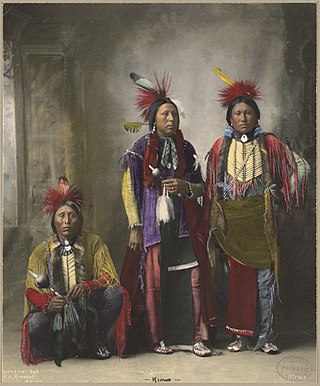
Kiowa or Ka'igwu people are a Native American tribe and an indigenous people of the Great Plains of the United States. They migrated southward from western Montana into the Rocky Mountains in Colorado in the 17th and 18th centuries, and eventually into the Southern Plains by the early 19th century. In 1867, the Kiowa were moved to a reservation in southwestern Oklahoma.

The Battle of the Washita River occurred on November 27, 1868, when Lt. Col. George Armstrong Custer's 7th U.S. Cavalry attacked Black Kettle's Southern Cheyenne camp on the Washita River.
The Dull Knife Fight, or the Battle on the Red Fork, part of the Great Sioux War of 1876, was a battle that was fought on November 25, 1876, in present-day Johnson County, Wyoming between soldiers and scouts of the United States Army and warriors of the Northern Cheyenne. The battle essentially ended the Northern Cheyennes' ability to continue the fight for their freedom on the Great Plains.

The Colorado War was an Indian War fought in 1864 and 1865 between the Southern Cheyenne, Arapaho, and allied Brulé and Oglala Sioux peoples versus the U.S. Army, Colorado militia, and white settlers in Colorado Territory and adjacent regions. The Kiowa and the Comanche played a minor role in actions that occurred in the southern part of the Territory along the Arkansas River. The Cheyenne, Arapaho, and Sioux played the major role in actions that occurred north of the Arkansas River and along the South Platte River, the Great Platte River Road, and the eastern portion of the Overland Trail. The United States government and Colorado Territory authorities participated through the 1st Colorado Cavalry Regiment, often called the Colorado volunteers. The war was centered on the Colorado Eastern Plains, extending eastward into Kansas and Nebraska.
The Kidder Fight, of July 2, 1867 refers to a skirmish near what is now Goodland, Kansas involving a detachment of ten enlisted men and an Indian scout of the United States 2nd Cavalry under the command of Second Lieutenant Lyman S. Kidder who were attacked and wiped out by a mixed Lakota and Cheyenne force. Two Lakota, including chief Yellow Horse were also killed. The fight occurred during the period of the Indian Wars on the western plains and was an incident in the campaign known as Hancock's War.

Čhetáŋ Sápa' (Black Hawk) (c. 1832 – c. 1890) was a medicine man and member of the Sans Arc or Itázipčho band of the Lakota people. He is most known for a series of 76 drawings that were later bound into a ledger book that depicts scenes of Lakota life and rituals. The ledger drawings were commissioned by William Edward Canton, a federal "Indian trader" at the Cheyenne River Indian Reservation. Black Hawk's drawings were drawn between 1880-1881. Today they are known as one of the most complete visual records of Lakota cosmology, ritual and daily life.

David Pendleton Oakerhater, also known as O-kuh-ha-tuh and Making Medicine, was a Cheyenne warrior and spiritual leader. He later became an artist and Episcopal deacon. In 1985, Oakerhater was the first Native American Anglican to be designated by the Episcopal Church as a saint.

The Great Sioux War of 1876, also known as the Black Hills War, was a series of battles and negotiations that occurred in 1876 and 1877 in an alliance of Lakota Sioux and Northern Cheyenne against the United States. The cause of the war was the desire of the US government to obtain ownership of the Black Hills. Gold had been discovered in the Black Hills, settlers began to encroach onto Native American lands, and the Sioux and the Cheyenne refused to cede ownership. Traditionally, American military and historians place the Lakota at the center of the story, especially because of their numbers, but some Native Americans believe the Cheyenne were the primary target of the American campaign.

Ledger art is a term for narrative drawing or painting on paper or cloth, predominantly practiced by Plains Indian, but also from the Plateau and Great Basin. Ledger art flourished primarily from the 1860s to the 1920s. A revival of ledger art began in the 1960s and 1970s. The term comes from the accounting ledger books that were a common source of paper for Plains Indians during the late 19th century.

Howling Wolf was a Southern Cheyenne warrior who was a member of Black Kettle's band and was present at the Sand Creek Massacre in Colorado. After being imprisoned in the Fort Marion in Saint Augustine, Florida in 1875, Howling Wolf became a proficient artist in a style known as Ledger art for the accounting ledger books in which the drawings were done.

The Battle of the Saline River in August 1867 was one of the first recorded combats of the Buffalo Soldiers of the U.S. 10th Cavalry. This battle occurred 25 miles northwest of Fort Hays in Kansas near the end of August 1867.[see discussion]
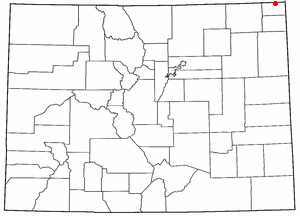
The Battle of Julesburg took place on January 7, 1865, near Julesburg, Colorado between 1,000 Cheyenne, Arapaho, and Lakota Indians and about 60 soldiers of the U.S. army and 40 to 50 civilians. The Indians defeated the soldiers and over the next few weeks plundered ranches and stagecoach stations up and down the South Platte River valley.
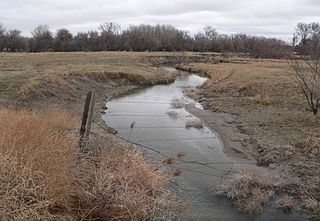
The Battle of Rush Creek took place February 8–9, 1865, between about 185 soldiers of the U.S. Army and 1,000 warriors of the Lakota Sioux, Cheyenne, and Arapaho tribes. It was part of a series of retaliations by the Native American alliance after the U.S. army committed the Sand Creek Massacre. The inconclusive battle took place 4 mi southeast of present-day Broadwater, Nebraska, along both banks of the North Platte River.

White Swan (c.1850—1904), or Mee-nah-tsee-us in the Crow language, was one of six Crow Scouts for George Armstrong Custer's 7th Cavalry Regiment during the 1876 campaign against the Sioux and Northern Cheyenne. At the Battle of the Little Bighorn in the Crow Indian Reservation, White Swan went with Major Reno's detachment, and fought alongside the soldiers at the south end of the village. Of the six Crow scouts at the Battle of the Little Bighorn, White Swan stands out because he aggressively sought combat with multiple Sioux and Cheyenne warriors, and he was the only Crow Scout to be wounded in action, suffering severe wounds to his hand/wrist and leg/foot. After being disabled by his wounds, he was taken to Reno's hill entrenchments by Half Yellow Face, the pipe-bearer (leader) of the Crow scouts, which no doubt saved his life.
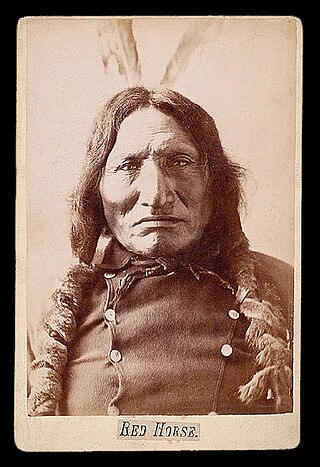
Red Horse was a sub-chief of the Miniconjou Sioux. He fought in the 1876 Battle of the Little Bighorn, and in 1881 he gave one of the few detailed accountings of the event. He also drew pictographs of the Little Bighorn Battle. Red Horse married twice and had three children.
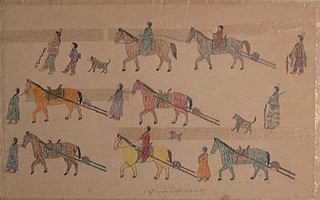
Annie Little Warrior (1895–1966) was a Hunkpapa Lakota artist from the Standing Rock Reservation and an early woman ledger artist. She was also known by the names Annie Red Tomahawk and Mrs. Henry Red Tomahawk.
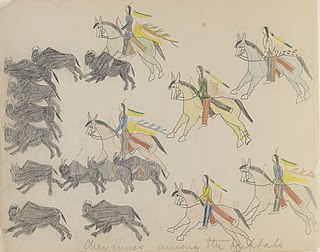
Bear's Heart was a Cheyenne ledger book artist who was one of 72 Native Americans to be imprisoned in 1875 at Fort Marion, in St. Augustine, Florida. While imprisoned, he created a series of drawings on ledger book pages using ink and colored pencils. In November 1876 he created a set of drawings known as the Bear's Heart Ledger Book.

The murder trial of seven Cheyenne took place in 1879 in Dodge City and Lawrence, Kansas. Seven Native American (Indian) warriors were accused of killing 40 civilians in Decatur County, Kansas. The killings took place during the Northern Cheyenne Exodus in which 353 Cheyenne men, women, and children fled their reservation in Indian Territory and attempted to return to their homeland on the northern Great Plains. The imprisonment and trial of the seven Cheyenne took place over a period of eight months and was widely publicized and controversial. A judge concluded the trial by dismissing the murder charges on the seven. The Ledger art created by several of the Cheyenne while imprisoned is preserved in museums.




